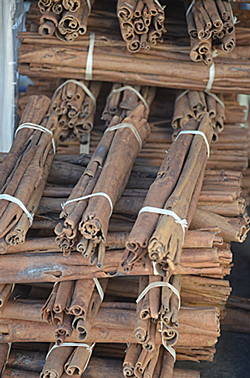|
| |
|
|
|
|
| |
         
|
 Interesting Facts...
 |
In Herodotus and other authors, Arabia was the source of cinnamon: giant Cinnamon birds collected the cinnamon sticks from an unknown land where the cinnamon trees grew and used them to construct their nests; the Arabs employed a trick to obtain the cinnamon sticks. This story was current as late as 1310 in Byzantium, although in the first century, Pliny the Elder had written that the traders had made this up in order to charge more for cinnamon. Before the foundation of Cairo, Alexandria was the Mediterranean shipping port of cinnamon. Europeans who knew the Latin writers who were quoting Herodotus knew that cinnamon came up the Red Sea to the trading ports of Egypt, but whether from Ethiopia or not was less than clear.
Cinnamon is harvested
by growing the tree for two years then coppicing it.
The next year, about a dozen shoots will form from
the roots of cinnamon tree.
The bark of cinnamon tree must be processed immediately after harvesting while still wet. Once processed, the bark will dry completely in four to six hours, provided that it is in a well-ventilated and relatively warm environment. A less than ideal drying environment encourages the proliferation of pests in the bark, which may then require treatment by fumigation. Bark treated this way is not considered to be of the same premium quality as untreated bark. Cinnamon's unique healing abilities come from three basic types of components in the essential oils found in its bark. These oils contain active components called cinnamaldehyde, cinnamyl acetate, and cinnamyl alcohol, plus a wide range of other volatile substances. We are suppliers of cinnamon from MadagascarFor further information about cinnamon from Madagascar like availability, quality, price, please contact us.
|
| Kautilya Commodities © 2011 | Privacy Policy |



